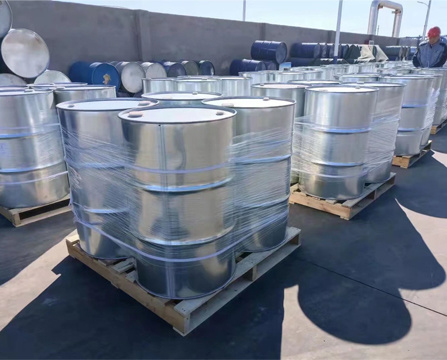Chemical storage conditions need to pay attention to some
Time:
2024-05-13
Matters needing attention in the storage conditions of chemicals
1. Introduction
With the development of modern industry, the wide application of chemicals has brought a lot of convenience, but it also brings safety risks. In order to ensure the safe use and storage of chemicals and reduce the possibility of accidents, this paper describes the storage conditions of chemicals in detail.
Basic principles of 2. chemical storage
1. Follow laws and regulations: Comply with national laws and regulations on the storage of hazardous chemicals to ensure storage safety.
Separate storage: Different types of chemicals should be stored separately to avoid accidents caused by mutual influence.
3. Clear identification: each storage area should have a clear identification, indicating the chemical name, danger and other information.
Specific considerations for 3. storage conditions
1. Environmental factors
(1) temperature: to ensure that the storage environment temperature is appropriate, to avoid too high or too low temperature on the impact of chemicals. For specific chemicals, the temperature range should be strictly controlled to ensure its safety and stability.
(2) Humidity: Keep the humidity of the storage environment suitable to prevent chemical moisture absorption, agglomeration or chemical reaction.
(3) Light: Avoid exposing chemicals to strong sunlight for a long time to avoid triggering photolysis reactions or accelerating chemical reactions.
(4) Ventilation: Ensure that the storage area is well ventilated to reduce the concentration of harmful gases or steam and reduce safety hazards.
2. Classified storage of chemicals
(1) Flammable chemicals: they should be stored in areas with high fire rating, away from fire sources and heat sources, and equipped with corresponding fire extinguishing facilities.
(2) Toxic chemicals: should be stored in a well-ventilated area, and set up obvious warning signs to prevent personnel contact.
(3) Corrosive chemicals: It should be stored in corrosion-resistant shelves or cabinets to avoid accidents caused by contact with other items.
(4) Explosives: should be stored in special explosion-proof facilities, away from fire, heat and other flammable items.
4. storage facilities and equipment requirements
1. Storage facilities: Ensure that storage facilities such as shelves, cabinets, etc. are structurally stable and can withstand the weight and pressure of chemicals.
2. Fire prevention facilities: according to the danger of chemicals, equipped with corresponding fire extinguishing equipment and facilities, such as fire extinguishers, fire blankets, etc.
3. Anti-leakage facilities: In order to prevent chemical leakage, anti-leakage containers, cofferdams and other facilities should be equipped to ensure that leakage can be controlled in time.
4. Safety monitoring: Install monitoring equipment to monitor the storage area in real time to ensure the safety of chemicals.
5. Personnel Management Requirements
1. Training: Provide professional training to personnel responsible for chemical storage and management to improve their safety awareness and ability to respond to emergencies.
2. Clear responsibilities: clarify the responsibilities and authorities of personnel at all levels to ensure that they can respond quickly in emergency situations.
3. Inspection system: Establish an inspection system, regularly inspect the storage area, and deal with problems found in time.
6. emergency measures
Formulation of emergency plan: formulate corresponding emergency plan according to the nature of chemicals, and specify the emergency treatment process and responsible person. To ensure a prompt and effective response in emergency situations. Strengthen drills: organize emergency drills regularly to improve the ability of employees to respond to emergencies. Establish contact channels: keep in touch with local emergency management departments so that they can get timely assistance in emergency situations. Strengthen collaboration and communication: The departments should strengthen collaboration and communication to ensure that they can respond quickly and deal with accidents in emergency situations. Periodic Risk Assessment and Review Periodic Risk Assessment and Review of Chemical Storage Periodic Risk Assessment and Review of Chemical Storage Update Relevant Facilities and Emergency Plans Timely Update the Ability to Respond to Emergencies Ensure the Safety of Personnel and Property Summary This paper summarizes the precautions for chemical storage conditions from environmental factors, classified storage, storage facilities and equipment requirements, personnel management requirements, emergency response measures and other aspects to ensure the safe use of chemicals and storage Reduce the possibility of accidents in practical work, the requirements described in this article should be strictly followed to ensure the safety of personnel and property. 7. conclusion to sum up, the storage conditions of chemicals involve many important safety factors, including environmental factors, classified storage, personnel management requirements for storage facilities and equipment, emergency response measures, etc. In actual operation, relevant regulations and requirements must be strictly observed to ensure the safe use and storage of chemicals. Through strengthening management and training, personnel's safety awareness and response ability are improved to ensure the safety of personnel and property. ", the" 7. conclusion "section can be supplemented with the following: in short, (the supplemented section can be a summary or outlook of the previous section). For the storage of chemicals, (subject to expansion of content depending on the actual situation), continued efforts are needed to improve storage safety and response capabilities. As technology advances and regulations improve, we look forward to a safer and more efficient chemical storage environment. Through continuous practice and improvement, we can achieve this goal and contribute to the sustainable development of society.
Key words:
Ketones
Alcohols





